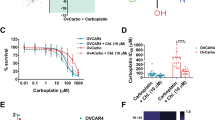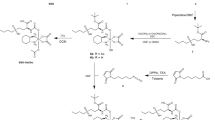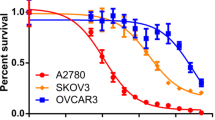Abstract
Intrinsic resistance to existing clinical platinum drugs is a major cause of treatment failure; moreover, these agents have the drawbacks of cross-resistance and intravenous administration. The mechanism of intrinsic cisplatin resistance and the mechanism of circumvention of intrinsic resistance by a member (JM221) of the ammine/amine platinum (IV) dicarboxylate class of platinum complex was studied in intrinsically resistant (SKOV-3) and sensitive (41M) human ovarian carcinoma cell lines. JM221 reduced the cisplatin resistance factor nine- to 2.7-fold, was more potent than cisplatin and showed marked time-dependent cytotoxicity. Cellular platinum accumulation was 20- to 40-fold greater (P < 0.001), and DNA platination was fourfold greater (P < 0.02), immediately following 2 h equimolar exposure to JM221, compared with cisplatin. DNA platinum levels decreased following cisplatin exposure with a half-life approximating 48 h in both lines, while no net removal of DNA-bound platinum was recorded following JM221 exposure. JM221 caused DNA interstrand cross-linking, but this was 10-20% less frequent with JM221 than with cisplatin when expressed as a proportion of total DNA platinum lesions. Cisplatin DNA interstrand cross-linking was twofold greater in the intrinsically sensitive line (41M) than in the resistant line (SKOV-3) over a range of concentrations and time-points. Neither cellular platinum accumulation, levels of DNA platination nor the rate of removal of DNA-bound platinum in the two cell lines related to their ninefold difference in cisplatin sensitivity. Intrinsic cisplatin resistance appears to be attributable to the inhibition of formation of bifunctional DNA lesions, while the circumvention of intrinsic resistance by JM221 seems to be the result of both improved transport properties and circumvention of DNA repair mechanisms.
This is a preview of subscription content, access via your institution
Access options
Subscribe to this journal
Receive 24 print issues and online access
$259.00 per year
only $10.79 per issue
Buy this article
- Purchase on Springer Link
- Instant access to full article PDF
Prices may be subject to local taxes which are calculated during checkout
Similar content being viewed by others
Author information
Authors and Affiliations
Rights and permissions
About this article
Cite this article
McKeage, M., Abel, G., Kelland, L. et al. Mechanism of action of an orally administered platinum complex [ammine bis butyrato cyclohexylamine dichloroplatinum (IV) (JM221)] in intrinsically cisplatin-resistant human ovarian carcinoma in vitro. Br J Cancer 69, 1–7 (1994). https://doi.org/10.1038/bjc.1994.1
Issue Date:
DOI: https://doi.org/10.1038/bjc.1994.1



